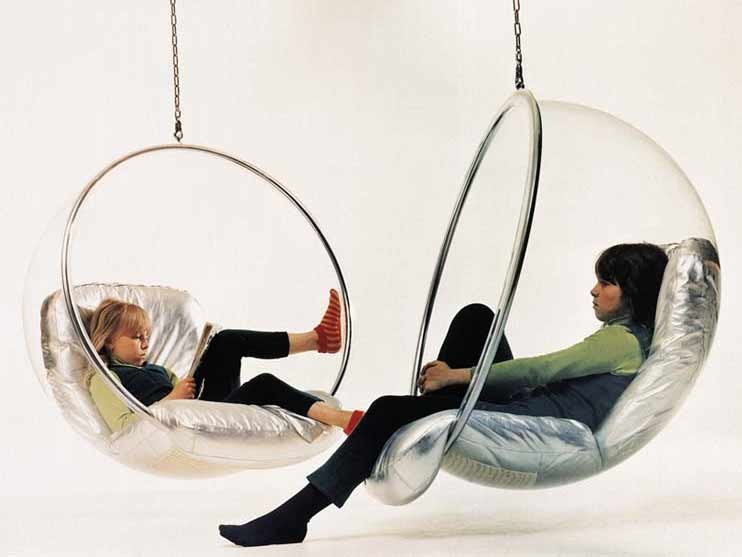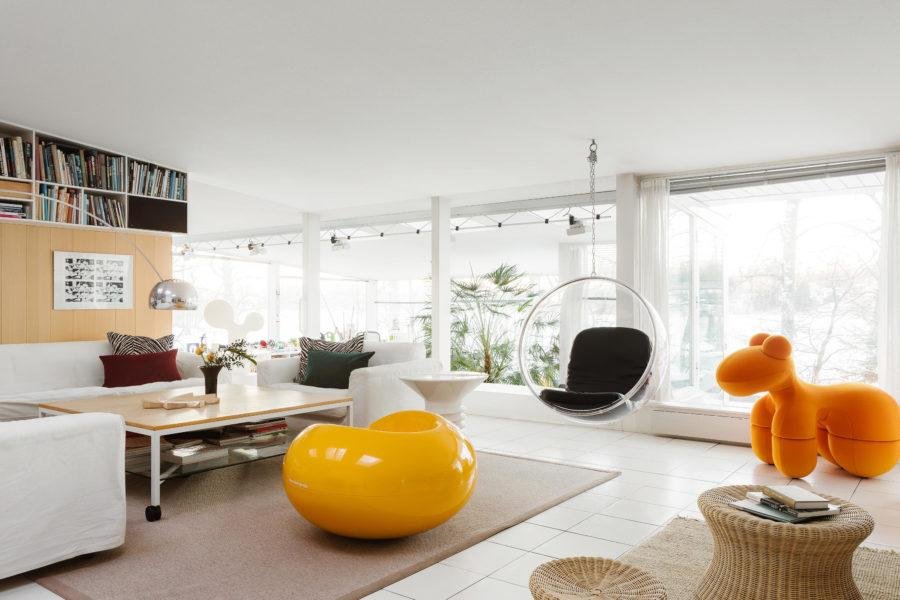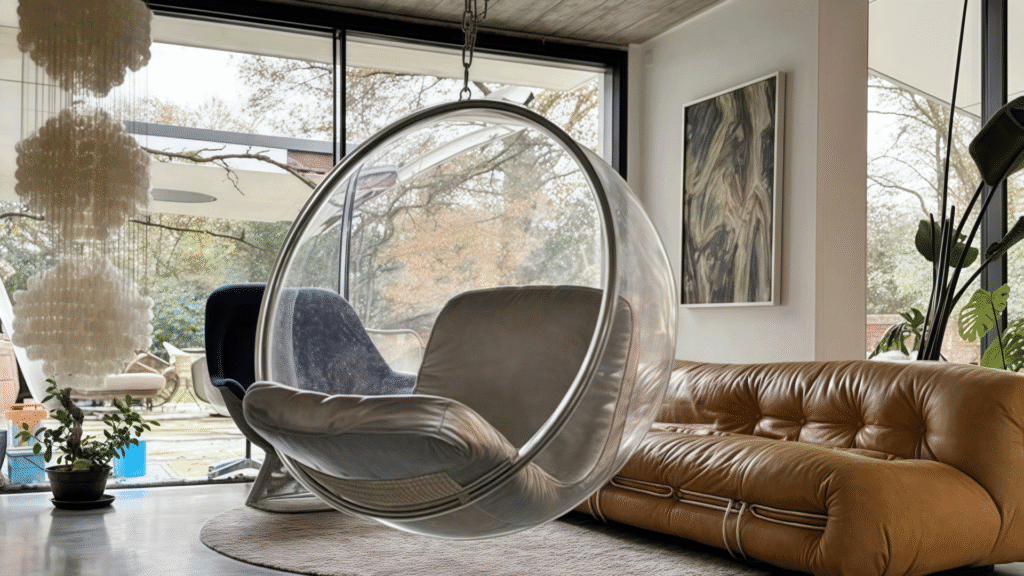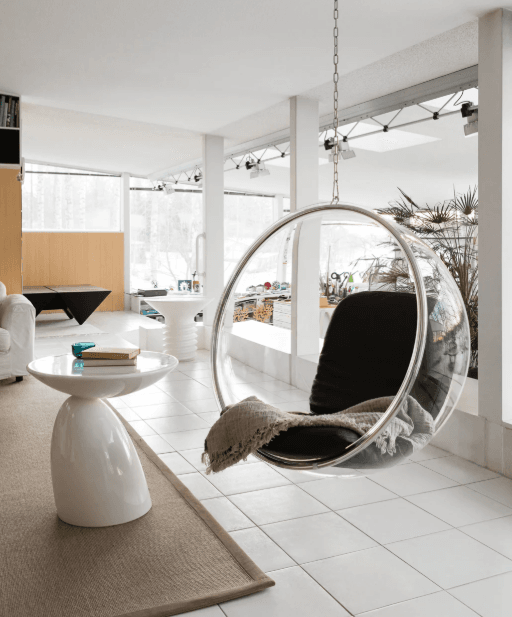
Introduction
The Bubble Chair stands as one of the most recognizable and innovative pieces of modern furniture design, representing a pivotal moment when designers dared to imagine what seating could become. Conceived by Finnish visionary Eero Aarnio in 1968, this suspended transparent acrylic sphere transformed how we think about personal space, comfort, and the relationship between occupant and environment. Unlike traditional chairs anchored to the ground, the Bubble Chair hangs gracefully from the ceiling, creating the illusion of floating within its own private world—a cocoon that both isolates and connects the user to their surroundings.
The chair’s journey from conceptual sketch to international design icon reveals much about the creative process, material innovation, and cultural zeitgeist of the 1960s. What began as a practical solution to a design problem evolved into a symbol of the Space Age movement, appearing in museum collections worldwide and influencing generations of designers. Today, nearly six decades after its debut, the Bubble Chair remains a coveted statement piece for discerning homeowners, office designers, and cultural institutions seeking to merge form with function in extraordinary ways.
This comprehensive guide explores the history, design innovations, practical applications, and contemporary relevance of the Bubble Chair. Whether you are a design enthusiast, interior professional, or prospective owner, understanding this masterpiece provides valuable insights into how imaginative thinking and material experimentation can reshape our living spaces.
The Origins and Design Evolution: From Ball to Bubble
The Bubble Chair cannot be fully appreciated without understanding its predecessor: the Ball Chair, which Eero Aarnio created in 1963. This distinction is crucial because it reveals Aarnio’s creative methodology—innovation through refinement, problem-solving through reinvention.
Aarnio’s fascination with creating extraordinary furniture began in his youth. As a child, he had blown soap bubbles from a barn in the Finnish countryside, watching them float away into the distance. This childhood memory would resurface decades later when he conceived the Bubble Chair, demonstrating how profound design inspiration often stems from simple, universal human experiences. In 1962, Aarnio established his own design studio in Helsinki, driven by the ambition to create furniture that would capture attention and imagination.
The Ball Chair emerged from Aarnio’s early experiments with fiberglass, a material that had only recently become accessible for commercial furniture production. After international patents expired, designers gained the freedom to explore this revolutionary material’s potential. Aarnio recognized that curved, organic forms were ideally suited to fiberglass’s malleability and strength. Rather than creating incremental improvements on existing designs, he envisioned something radical: a complete sphere that would function as a private chamber—a room within a room.
When the Ball Chair debuted at the 1966 Cologne Furniture Fair, it caused immediate sensation. Retailers from thirty countries placed orders within the first week. The chair’s distinctive features included a padded interior upholstered in leather, a single opening for entry and exit, and a rotating pedestal base that allowed occupants to turn toward or away from their environment.
However, despite the Ball Chair’s critical success, Aarnio identified a significant limitation: insufficient internal lighting made reading inside the sphere uncomfortable. This practical challenge sparked his imagination. Rather than abandon the design, he asked a revolutionary question: could the shell itself be transparent?
The solution emerged from an unlikely source—dome-shaped acrylic skylights. Aarnio researched how manufacturers created these transparent ceiling elements and discovered that acrylic could be heated and blown into spherical shapes, similar to soap bubbles. This manufacturing technique became the key to revolutionizing his design. By using transparent acrylic material, he could create a chair that maintained the Ball Chair’s protective, acoustic qualities while flooding the interior with light from all directions.
Yet another challenge arose: how to attach the transparent shell to a support structure without compromising aesthetics. After experimenting with various pedestal designs, Aarnio concluded that no clear or transparent base would achieve the desired visual harmony. The solution was elegant in its simplicity: hang the chair from the ceiling. This decision transformed not just the chair’s appearance but its entire psychological impact. Rather than sitting upon a structure, users could experience the sensation of floating—suspended in a transparent bubble that seemed to defy gravity.
Aarnio finalized his design in 1968, selecting a chrome-plated steel frame to support the acrylic shell and a sturdy metal chain for suspension from the ceiling. The interior featured white leather cushioning as the original upholstery, though modern variations have introduced alternative materials and colors. The finished chair measured approximately 105 centimeters in width, 108 centimeters in height, and 83 centimeters in depth—dimensions carefully calculated to provide comfortable seating for a single occupant while maintaining visual elegance.
Material Innovation: Transparent Acrylic and Structural Engineering
The Bubble Chair represents a watershed moment in applying advanced materials to furniture design. Understanding the material composition and manufacturing process reveals why this chair maintained its design integrity and desirability across multiple decades.
Acrylic polymethyl methacrylate (PMMA), the primary material of the Bubble Chair’s shell, offers distinctive properties that make it uniquely suited to this application. Unlike traditional glass, acrylic provides superior impact resistance, exceptional transparency comparable to optical-quality glass, and remarkable workability. The material can withstand temperature fluctuations without becoming brittle, resists UV degradation better than many plastics, and maintains its clarity indefinitely when properly maintained.

| Material Component | Specification | Design Function |
|---|---|---|
| Acrylic Shell | 10-12mm thickness, transparently blown | Primary protective enclosure |
| Steel Frame | Chrome-plated circular ring | Structural support and definition |
| Metal Chain | Typically 2 meters, grade-rated | Suspension and height adjustment |
| Interior Cushion | Leather or upholstered foam | Comfort and acoustic absorption |
| Fixing Hardware | Industrial-grade eye bolts, hooks | Ceiling attachment and load distribution |
The manufacturing process for the Bubble Chair shell employs a specialized technique called thermoforming and blow-molding. Acrylic sheets are heated to precise temperatures that render them plastic without losing structural integrity. Within a steel frame forming the boundary, compressed air expands the heated acrylic outward, creating the spherical shape—precisely replicating the natural formation of a soap bubble. This production method required no complex molds, which Aarnio deliberately avoided because mold marks would have disrupted the desired seamless appearance.
The steel frame functions as both structural skeleton and visual boundary marker. Rather than disappearing into the design, the frame is deliberately visible—a design choice that emphasizes the marriage of industrial materials with organic forms. The chrome plating prevents corrosion while creating a subtle reflective quality that complements the transparent acrylic.
One often-overlooked engineering achievement in the Bubble Chair is its acoustic properties. The combination of acrylic’s inherent sound absorption characteristics and the enclosed spherical shape creates a space where external noise is substantially reduced. Occupants report an almost cocoon-like acoustic environment, where the rushing noise of surrounding spaces becomes muted. This acoustic isolation occurs not through sound-deadening materials but through geometric design—the spherical shape naturally disperses and absorbs sound waves.
The structural integrity of the Bubble Chair derives from careful weight distribution. A single occupant exerts force downward through the interior cushioning. The curved walls channel this force evenly along the spherical surface toward the steel frame, which transfers all weight to the ceiling mounting point. This elegant structural solution means that despite being suspended by a single attachment point, the chair distributes loads safely and comfortably.
Modern manufacturers have preserved Aarnio’s specifications while introducing advanced acrylic formulations offering increased scratch resistance and enhanced UV protection. Premium versions utilize optically-graded acrylic comparable to aircraft windshields, ensuring crystal clarity that deteriorates minimally over decades.
The Bubble Chair in Contemporary Interior Design
Understanding how the Bubble Chair functions within modern interior environments reveals its continued relevance and remarkable design versatility. Rather than appearing dated or confined to historical preservation, contemporary applications demonstrate this design’s unique ability to enhance diverse spatial and aesthetic contexts.
Residential Applications and Personal Spaces
In residential settings, the Bubble Chair typically occupies roles that emphasize contemplation, reading, and personal retreat. Interior designers strategically position these chairs near windows to maximize natural light while creating visual drama. The transparent acrylic frames views beyond the chair, creating multiple layers of visual depth within a room. A Bubble Chair positioned against a window becomes simultaneously a seat and a sculptural art installation—catching and refracting light throughout the day while providing functional comfort.
Bedroom applications have become increasingly popular, with Bubble Chairs creating sophisticated reading nooks that feel infinitely more exclusive than conventional furniture. The chair’s enclosed form acknowledges the private nature of bedrooms while its transparency maintains visual connection to the larger space. During evening hours, when positioned near a window overlooking garden or cityscape, the chair becomes a meditation vessel—inhabitants suspended between interior safety and exterior wonder.
Living room installations leverage the Bubble Chair as a conversation starter and spatial focal point. Rather than serving as primary seating for multiple occupants, the chair functions as a distinctive accent piece that draws attention. Interior designers often pair a Bubble Chair with complementary furniture in contrasting materials—perhaps leather sofas or natural wood tables—creating visual tension that generates sophisticated design interest.
| Application Context | Typical Placement | Design Impact | Lighting Consideration |
|---|---|---|---|
| Bedroom Reading Nook | Near window or corner | Personal retreat, focal point | Natural daylight preferred |
| Living Room Installation | Strategic visibility location | Sculptural conversation piece | Works in various light conditions |
| Office Workspace | Executive area, meeting space | Status symbol, creative inspiration | Positioned for ceiling light |
| Creative Studio | Artist/designer work areas | Inspiration chamber, thinking space | Skylight or ceiling lights ideal |
| Library Corner | Quiet reading area | Immersive literary experience | Natural or warm artificial light |
Commercial and Professional Environments
Commercial applications reveal the Bubble Chair’s unexpected versatility beyond residential luxury. Progressive companies have adopted these chairs in office environments, recognizing their value as both functional pieces and cultural signals. A Bubble Chair in an executive office communicates sophistication, commitment to design excellence, and willingness to think unconventionally. These chairs often become meeting or telephone spaces—Aarnio famously installed telephones in some chairs, recognizing them as natural private communication chambers.
Creative agencies, design studios, and technology companies frequently incorporate Bubble Chairs into break areas and informal meeting spaces. The chair’s distinctive aesthetic aligns naturally with innovative corporate cultures seeking to visually communicate their forward-thinking orientation. The chair’s acoustic isolation properties also make it valuable for confidential conversations or focused creative work requiring minimal distractions.
Hospitality venues have embraced the Bubble Chair, most notably in high-end hotels. The Sanderson Hotel in London features a Bubble Chair in its lobby, serving as both functional seating and visual anchor for its design-forward aesthetic. Boutique hotels and luxury resorts have recognized that Bubble Chairs communicate exclusivity and cultural sophistication to discerning guests.
Educational and Cultural Institutions
Museums worldwide feature the Bubble Chair in permanent design collections, recognizing its status as an industrial design masterpiece. Institutions including the Victoria and Albert Museum in London, MoMA in New York, the Vitra Design Museum in Germany, and Centre Georges Pompidou in Paris have all acquired original or authenticated examples. Educational institutions use Bubble Chairs in design programs to teach principles of material innovation, structural engineering, and aesthetic vision.
Design schools display Bubble Chairs not merely as historical artifacts but as teaching tools. Students studying furniture design, materials science, and spatial design interact with these chairs to understand how imagination transforms materials into lasting cultural objects. The chair’s presence in academic environments reinforces its status as a fundamental reference point for twentieth-century design thinking.
Aesthetic and Psychological Dimensions
The Bubble Chair engages occupants on multiple psychological and perceptual levels that transcend simple functional seating. Understanding these dimensions explains the enduring fascination with this design across generations and cultural contexts.
Visual and Spatial Psychology

From a perceptual standpoint, the Bubble Chair creates what environmental psychologists term spatial ambiguity. The transparent material simultaneously includes and excludes occupants from their surroundings. An occupant sitting in the chair remains visually connected to the surrounding space—able to see out in all directions—while being psychologically separated by the acrylic boundary. This unique condition creates a meditative state where individuals feel protected without sensation of claustrophobia.
The illusion of floating contributes significantly to the chair’s psychological impact. Traditional seating connects users to the floor through visible support structures, creating unconscious grounding sensations. The Bubble Chair’s ceiling suspension inverts this expectation, generating subtle psychological elevation. Occupants report sensations of weightlessness and transcendence—states that designers and architects explicitly cultivate through environmental manipulation.
The geometric perfection of the spherical form conveys visual stability and completeness. Spheres appear in nature, architecture, and design as symbols of perfection and wholeness. This symbolic dimension—often operating at unconscious perceptual levels—contributes to the chair’s aesthetic appeal beyond its functional properties.
| Psychological Factor | Perception | Behavioral Response |
|---|---|---|
| Spatial Enclosure | Protected privacy within transparency | Reduced anxiety, enhanced focus |
| Visual Connection | Ability to see outward unobstructed | Maintains environmental awareness |
| Sensation of Floating | Ceiling suspension defying gravity | Contemplative mood elevation |
| Spherical Geometry | Visual perfection and wholeness | Aesthetic satisfaction and harmony |
| Isolation with Connection | Psychological separation despite transparency | Unique meditative state |
Design Symbolism and Cultural Resonance
The Bubble Chair emerged during the 1960s space exploration era, a moment when humanity collectively imagined futures among the stars. While Aarnio has consistently stated that his design motivation centered on material innovation rather than space age symbolism, the chair inevitably resonates with that cultural moment. The spherical form echoes space capsules, and the transparent acrylic evokes spacecraft windows. This symbolic resonance, whether intended or emergent, contributes to the chair’s enduring cultural power.
The chair also represents design philosophy emphasizing humanization of technology. Rather than creating cold, industrial objects, Aarnio used plastic and acrylic—materials often associated with mass production and disposability—to create intimate, luxurious personal spaces. This paradoxical approach challenged assumptions about material hierarchies and design value.
In contemporary contexts, the Bubble Chair functions as a visual statement about lifestyle priorities. Ownership signals appreciation for design history, financial resources for designer furniture, and personality traits valuing individuality and visual boldness. The chair becomes less about seating than about identity expression and cultural positioning.
Installation, Maintenance, and Safety Considerations
Practical ownership of a Bubble Chair requires understanding installation complexities, ongoing maintenance requirements, and safety protocols. These practical dimensions are often overlooked yet essential for responsible chair ownership.
Structural Requirements and Installation Process
Successful Bubble Chair installation begins with comprehensive ceiling assessment. The chair suspension requires secure attachment to structural elements capable of supporting dynamic loads—typically 400-600 pounds including occupant weight and movement forces. Installation requires identifying ceiling joists or beams using professional-grade stud finders or, for maximum security, consulting structural engineers.
Optimal ceiling materials include solid wood joists, concrete beams, or steel support structures. Drywall or drop ceilings provide insufficient support and should never be installation points. Professional installation is strongly recommended, particularly in residential settings where ceiling damage represents significant liability.
Hanging chain length requires careful calibration. Standard positioning places the chair’s lowest point approximately 18-24 inches above the floor, allowing comfortable access while maintaining proportional visual balance. The chair’s top typically hangs 3-4 feet from ceiling, accounting for occupant head space and chain length. Professional installers typically adjust chain length ±6 inches after initial installation, testing comfort and safety parameters.
| Installation Parameter | Specification | Critical Importance |
|---|---|---|
| Ceiling Support Rating | Minimum 600 lbs static load | Prevents structural failure |
| Joist Diameter | Minimum 2×6″ dimension | Ensures load distribution |
| Mounting Hardware Grade | Industrial-rated eye bolts | Prevents suspension failure |
| Clearance from Walls | Minimum 14-18 inches | Allows safe rocking motion |
| Floor Clearance | 18-24 inches chair bottom | Safe access and exit |
| Chain Length Adjustment | Allows ±6″ modification | Comfort and safety optimization |
Safety inspection protocols should occur annually, examining chain condition for corrosion or weakening, verifying eye bolt tightness, and assessing ceiling structure for deterioration. Any visible wear, creaking sounds, or structural concerns warrant immediate professional inspection before continued use.
Acrylic Care and Long-Term Preservation

The transparent acrylic shell requires periodic maintenance to preserve clarity and aesthetic appeal. Regular cleaning with soft microfiber cloths and specialized acrylic-safe cleaners prevents dust accumulation and maintains optical transparency. Harsh chemical cleaners, abrasive materials, and ammonia-based solutions should be avoided, as they degrade acrylic and create surface hazing.
Exposure to extended direct sunlight, while not immediately damaging acrylic, can gradually cause slight discoloration over decades. Interior positions with natural light providing illumination without direct sun exposure optimize visual clarity and color preservation.
Temperature fluctuations create microscopic expansion and contraction cycles in acrylic. While modern formulations resist degradation from normal indoor temperature variations, positioning chairs away from heating vents or direct air conditioning sources minimizes stress on the material.
Occupant weight capacity typically ranges from 250-350 pounds, depending on manufacturing specifications. Exceeding stated weight limits risks acrylic stress fracturing and structural failure. Regular users should verify their weight against manufacturer specifications and never exceed stated limits.
The interior cushioning, typically constructed from polyurethane foam or latex, requires maintenance similar to other upholstered furniture. Cushion covers should be professionally cleaned annually, and foam replacement becomes necessary after 10-15 years of regular use as materials naturally compress and deteriorate.
Variations and Contemporary Interpretations
While the original Bubble Chair design remains the archetypal reference, contemporary manufacturers have introduced variations exploring different materials, dimensions, and aesthetic approaches while respecting Aarnio’s fundamental design principles.
Modern Material Alternatives
Contemporary versions maintain the spherical form but experiment with alternative materials offering practical advantages. Some manufacturers utilize polycarbonate—a material offering superior impact resistance compared to acrylic while maintaining comparable transparency. Polycarbonate resists scratching more effectively and withstands greater stress before cracking, though it typically costs more than acrylic and may develop slight cloudiness over extended periods.
High-end luxury manufacturers have introduced smoked acrylic versions, where slight gray or bronze tinting reduces light transmission while maintaining visibility. These variations appeal to owners prioritizing aesthetic novelty and partial privacy over transparency. Colored acrylic options—soft pastels or saturated hues—represent more dramatic departures from the original, allowing design integration with specific interior color schemes.
Dimensional and Functional Variations
Larger-scaled variations now accommodate two-person seating while maintaining the suspended form. These expanded versions require corresponding ceiling reinforcement and more substantial chain systems, yet preserve the original’s essential psychological and aesthetic qualities. Smaller-scaled portable versions with floor stands rather than ceiling suspension offer the visual language without structural installation requirements, though they sacrifice the distinctive floating sensation.
Contemporary interpretations include hybrid designs merging the Bubble Chair’s form language with alternative support structures. Some studio designers have created base-supported variants using sculptural pedestals or wall-mounted brackets, extending the design vocabulary while maintaining transparency and spherical enclosure.
Upholstery and Interior Finish Innovations
Modern cushioning options have expanded dramatically beyond the original white leather. Contemporary versions offer materials including performance fabric suitable for commercial environments, leather in multiple colors, durable mesh for casual settings, and specialized microfiber facilitating easy cleaning. These material variations allow design integration into diverse aesthetic contexts while maintaining the form’s integrity.
Interior LED lighting systems represent a significant functional innovation. Some contemporary versions include subtle integrated lighting that transforms the Bubble Chair into an intimate lighting element, particularly valuable in evening hours or dim interior environments. This addition maintains transparency while adding functional illumination.
The Bubble Chair in Popular Culture and Media
The Bubble Chair’s distinctive visual character has made it a recurring element in popular culture, television, film, and music video production. This presence in media contexts reinforces its status as iconic contemporary design while introducing the object to audiences unfamiliar with design history.
Television productions have featured the Bubble Chair as a visual shorthand signifying sophistication, futurism, or luxury. Science fiction properties, recognizing the chair’s inherent connection to Space Age aesthetics, frequently incorporate it in set designs depicting future environments. The chair appears in professional office settings, luxury hotel scenes, and private residences depicted on screen as markers of refined aesthetic sensibility.
Film appearances have ranged from direct foreground positioning to background elements establishing visual tone. Music videos, particularly those exploring themes of isolation, introspection, or futurism, have adopted the Bubble Chair as a symbolic element creating visual interest while conveying psychological depth.
Celebrity and influencer adoption has dramatically increased contemporary visibility. High-profile personalities acquiring Bubble Chairs for residential or commercial spaces generate media attention through interior design publications and social media platforms. This contemporary celebrity association perpetuates the chair’s status as a desirable luxury object, shifting it from design museum artifact to aspirational consumer product.
| Media Context | Typical Function | Cultural Implication |
|---|---|---|
| Science Fiction Television | Future environment setting | Signals technological advancement |
| Music Video Production | Symbolic isolation element | Represents introspection or contemplation |
| Luxury Interior Photography | Status symbol display | Indicates refined aesthetic sensibility |
| Celebrity Home Features | Luxury lifestyle signifier | Aspirational consumer product marker |
| Commercial Advertisement | Premium brand association | Links product to design excellence |
Investment and Collecting Considerations

The Bubble Chair has emerged as a significant design collectible, with original Aarnio-authorized versions commanding premium prices in the luxury furniture market. Understanding valuation factors, authentication challenges, and investment considerations is essential for collectors and prospective owners.
Authentic Bubble Chairs produced through Aarnio Originals and authorized manufacturers typically retail between $4,000-$7,000 for standard versions, with premium options featuring custom upholstery, rare colors, or limited production editions reaching $10,000-$15,000. These price points reflect materials, manufacturing precision, design legacy status, and brand certification.
High-quality reproductions and unauthorized versions retail significantly lower, typically $800-$2,500, offering accessible entry points for individuals valuing the design aesthetic without investment-grade commitment. Quality variations among reproductions can be substantial, with material thickness, acrylic optical clarity, and hardware construction varying considerably.
Authentication becomes critical for investment-oriented purchasers. Authorized manufacturers produce documentation including certificates of authenticity, manufacturing dates, and material specifications. Professional auction houses such as Christie’s, Sotheby’s, and specialized design auction services authenticate significant pieces, verifying provenance and condition.
Condition assessment heavily influences value. Original chairs demonstrating decades of careful use may command premiums over newer versions if they retain visual clarity and structural integrity. Minor surface scratching typically does not substantially affect value, while major structural damage or acrylic cloudiness significantly diminishes worth.
The Bubble Chair has demonstrated relatively stable value appreciation, maintaining or increasing worth compared to inflation rates. Authentic examples in excellent condition have achieved consistent collector interest, suggesting the design’s enduring cultural and commercial significance.
Conclusion and Contemporary Relevance
The Bubble Chair represents far more than functional seating or aesthetic novelty. It embodies a specific moment when imaginative designers recognized that new materials and innovative thinking could fundamentally transform everyday objects into profound cultural statements. Nearly six decades after its conception, the chair continues influencing contemporary design while maintaining its distinctive visual and psychological power.
What distinguishes the Bubble Chair from other design classics is its refusal to become historically fixed. Rather than appearing dated or confined to period-specific appreciation, the chair seamlessly integrates into contemporary interior environments while maintaining clear historical significance. This unusual characteristic—maintaining both historical importance and present-day relevance—explains its continued presence in museum collections, commercial installations, and residential spaces.
For design enthusiasts, the Bubble Chair offers lessons in creative problem-solving, material mastery, and design thinking unconstrained by conventional limitations. For interior professionals, it demonstrates how distinctive form language can create spatial drama and psychological depth. For occupants, it provides an extraordinary functional object that transforms daily experience into contemplative meditation.
The chair’s ongoing influence appears in contemporary furniture design across multiple manufacturers and designers. The vocabulary of transparent enclosure, suspended forms, and psychologically complex spatial relationships that Aarnio pioneered continue appearing in contemporary work. Yet none successfully replicate the original’s unique combination of technical mastery, visual poetry, and psychological resonance.
Contemporary culture increasingly values design objects that merge functionality with artistic ambition, material innovation with philosophical depth, and visual distinction with emotional resonance. The Bubble Chair exemplifies these merged values, suggesting why Eero Aarnio’s 1968 creation remains perpetually contemporary. As design continues evolving, the Bubble Chair stands as testament to imagination’s power—a transparent sphere suspended in space that contains multitudes of meaning, emotion, and design significance.
Frequently Asked Questions
What is the exact weight capacity of the Bubble Chair?
Weight capacity varies by manufacturing version and material specifications. Original Aarnio Originals productions typically support occupants up to 280 pounds, while heavier-duty contemporary versions may accommodate up to 350 pounds. Always verify specific weight capacity with your manufacturer or authorized retailer before purchase. Exceeding stated weight limits risks acrylic stress cracking and potential failure. For individuals near or exceeding stated limits, professional consultation with the manufacturer is advisable before installation. Regular users should periodically verify their weight against specifications and contact manufacturers with concerns about capacity adequacy.
Can the Bubble Chair be used outdoors?
While acrylic resists UV degradation reasonably well, outdoor installation is not ideal for original Bubble Chair designs. Extended sunlight exposure creates gradual discoloration and may accelerate acrylic brittleness over time. Covered outdoor spaces such as screened porches or enclosed pavilions offer more suitable environments than fully exposed outdoor installation. If outdoor use is essential, polycarbonate alternatives provide superior UV resistance compared to acrylic. Professional installation in covered outdoor spaces should include careful assessment of temperature fluctuations, humidity exposure, and potential weather-related stress on acrylic structure.
How difficult is Bubble Chair installation, and can homeowners install it themselves?
Installation requires professional-grade skills including structural assessment, ceiling joist location, mounting hardware installation, and safety verification. While technically ambitious homeowners with carpentry experience might attempt installation, professional installation is strongly recommended due to safety implications. Improper installation risks ceiling damage, furniture failure, and personal injury. Professional installers provide insurance coverage, structural guarantees, and expertise assessing whether specific ceiling systems can safely support the chair. DIY installation should only be considered by individuals with demonstrated expertise in structural installation and full understanding of load requirements.
What is the difference between authentic Aarnio Originals versions and reproductions?
Authentic Bubble Chairs produced through Aarnio Originals employ premium acrylic of superior optical clarity, chrome-plated steel frames manufactured to exacting specifications, and industrial-grade hardware. These original versions include documentation, warranty coverage, and certification of authenticity. Reproductions vary dramatically in quality—some offering reasonable facsimiles of the original form, while others demonstrate significant compromises in material quality, manufacturing precision, and durability. Authentic versions justify premium pricing through superior materials, manufacturing standards, heritage value, and collectible status. Prospective buyers should request documentation verifying authenticity and examine material quality before purchase.
How often should the Bubble Chair be inspected for safety?
Annual safety inspections are recommended for regularly-used chairs, examining chain condition for corrosion or stretching, verifying eye bolt tightness, assessing ceiling structure for water damage or deterioration, and checking acrylic for stress cracks or cloudiness. Chairs in commercial environments with frequent use should be inspected semi-annually. Between professional inspections, users should periodically examine visible hardware for obvious loosening or corrosion and listen for creaking or unusual sounds during use. Any indication of structural concern warrants immediate professional inspection before continued use. Proper maintenance and regular inspection ensures years of safe, comfortable use while preserving design legacy.
What upholstery materials are available for contemporary Bubble Chairs?
Modern versions offer substantial cushioning material options beyond the original white leather. Options now include luxury leather in multiple colors, performance fabrics suitable for commercial environments, durable mesh for casual settings, and specialized microfiber facilitating easy cleaning. Premium versions may feature Italian leather or designer fabrics, while value-oriented options employ high-performance synthetic materials requiring minimal maintenance. Interior upholstery color and material selections significantly influence the chair’s aesthetic integration within specific design contexts. Prospective purchasers should examine material samples in their intended installation environments before finalizing selections, as lighting conditions dramatically influence material appearance and color perception.


